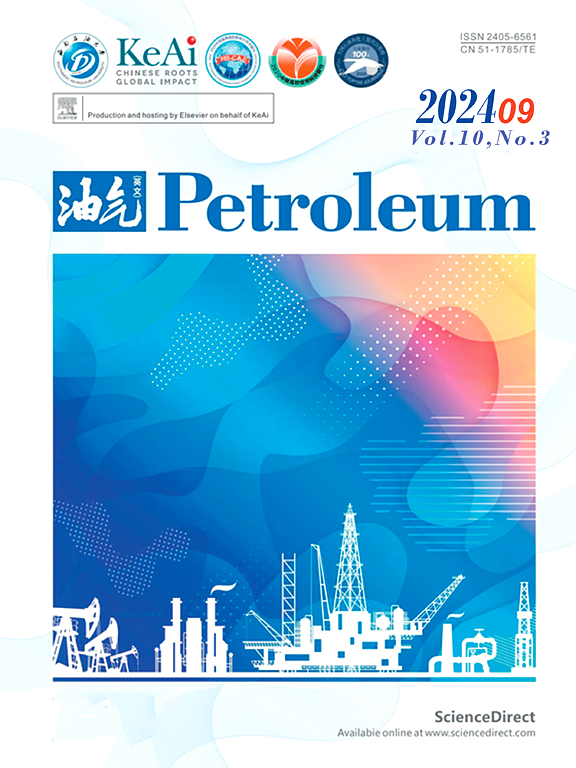化学提高采收率绿色材料研究进展
IF 4.2
Q2 ENERGY & FUELS
引用次数: 0
摘要
化学提高采收率(CEOR)以其在水驱后成功地回收储层中的困油而闻名。在CEOR中,使用合成化学品来增加毛管数量或改变储层的流动比;然而,它们是昂贵的,并且与环境问题有关。因此,环境意识的提高为环境友好和更便宜的替代品铺平了道路,例如绿色产品,以取代合成化学品。本文对近年来绿色产品在CEOR中的应用研究进行了综述。它还包括几个绿色产品的性能和他们的合成对手在CEOR的比较。此外,还分析了限制、成本和环境足迹。最后,重点介绍了绿色化学品的驱替效率及其面临的挑战。虽然在提高采收率中使用一些天然材料仍然会对环境产生影响,但它们是比合成化学品更安全的选择。此外,绿色材料比通常使用的合成化学品更便宜,使其成为提高采收率的经济可行选择。由于石油和天然气应用中天然化学利用的增长,迫切需要最新的概述。促进可持续替代品对于解决日益严重的全球环境问题至关重要。本文章由计算机程序翻译,如有差异,请以英文原文为准。
Advancements in green materials for chemical enhanced oil recovery: A review
Chemical enhanced oil recovery (CEOR) is well known for its success in recovering the trapped oil in reservoirs after waterflooding operations. In CEOR, synthetic chemicals are utilized to increase the capillary number or modify the mobility ratio of reservoirs; however, they are expensive and are associated with environmental concerns. Hence, the rise in environmental awareness paved the way for environmentally friendly and cheaper alternatives, such as green products, to replace synthetic chemicals. This paper comprehensively reviews recent studies on applying green products in CEOR. It also includes comparisons between the performance of several green products and their synthetic counterparts in CEOR. Moreover, limitations, cost, and environmental footprints are analyzed. Finally, the displacement efficiency of green chemicals and pertinent challenges in the field are highlighted. While the utilization of some natural materials in EOR still has an environmental impact, they constitute a safer option than synthetic chemicals. Furthermore, green materials are more affordable than synthetic chemicals that are commonly utilized, making them a financially viable option for EOR. An up-to-date overview is urgently needed due to the growth of natural chemical utilization in oil and gas applications. Promoting sustainable alternatives is essential to addressing the rise in global environmental concerns.
求助全文
通过发布文献求助,成功后即可免费获取论文全文。
去求助
来源期刊

Petroleum
Earth and Planetary Sciences-Geology
CiteScore
9.20
自引率
0.00%
发文量
76
审稿时长
124 days
期刊介绍:
Examples of appropriate topical areas that will be considered include the following: 1.comprehensive research on oil and gas reservoir (reservoir geology): -geological basis of oil and gas reservoirs -reservoir geochemistry -reservoir formation mechanism -reservoir identification methods and techniques 2.kinetics of oil and gas basins and analyses of potential oil and gas resources: -fine description factors of hydrocarbon accumulation -mechanism analysis on recovery and dynamic accumulation process -relationship between accumulation factors and the accumulation process -analysis of oil and gas potential resource 3.theories and methods for complex reservoir geophysical prospecting: -geophysical basis of deep geologic structures and background of hydrocarbon occurrence -geophysical prediction of deep and complex reservoirs -physical test analyses and numerical simulations of reservoir rocks -anisotropic medium seismic imaging theory and new technology for multiwave seismic exploration -o theories and methods for reservoir fluid geophysical identification and prediction 4.theories, methods, technology, and design for complex reservoir development: -reservoir percolation theory and application technology -field development theories and methods -theory and technology for enhancing recovery efficiency 5.working liquid for oil and gas wells and reservoir protection technology: -working chemicals and mechanics for oil and gas wells -reservoir protection technology 6.new techniques and technologies for oil and gas drilling and production: -under-balanced drilling/gas drilling -special-track well drilling -cementing and completion of oil and gas wells -engineering safety applications for oil and gas wells -new technology of fracture acidizing
 求助内容:
求助内容: 应助结果提醒方式:
应助结果提醒方式:


